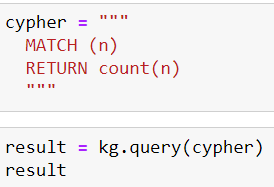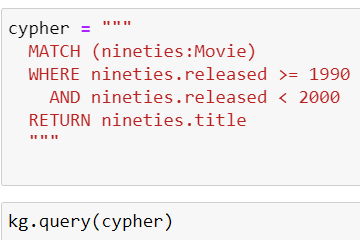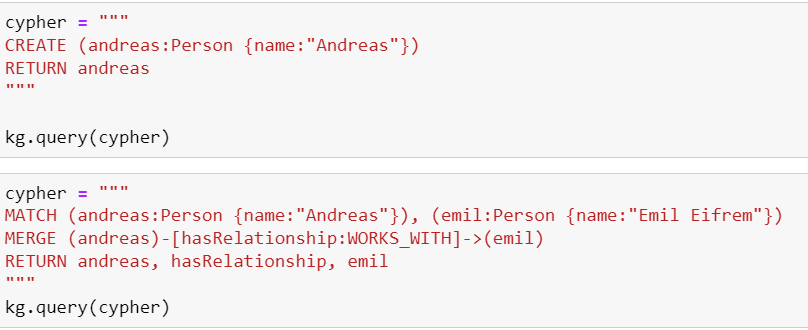Knowledge Graphs: Exploring Cypher Queries for Effective Data Retrieval
 Saurabh Naik
Saurabh Naik
Introduction:
In the ever-expanding landscape of data management, knowledge graphs stand out as powerful tools for organizing and leveraging information. A knowledge graph, structured as a database comprising nodes and relationships, offers a dynamic framework for storing and analyzing interconnected data points. To navigate and extract insights from these complex structures, Cypher queries serve as indispensable tools. In this blog, we embark on a journey to unravel the intricacies of knowledge graphs and delve into the realm of Cypher queries, exploring their applications in querying, retrieving, and manipulating data within knowledge graphs.
Understanding Knowledge Graphs:

A knowledge graph is more than just a database; it's a representation of interconnected knowledge, encapsulating entities as nodes and relationships as edges. Nodes and relationships can possess properties, providing additional context and metadata. Nodes can be categorized using labels, facilitating grouping and organization. Relationships, characterized by type and direction, establish connections between nodes, forming a rich tapestry of information.
Exploring Basic Cypher Queries for Knowledge Graphs:
Matching All Nodes:

Cypher queries can retrieve all nodes present in a knowledge graph, providing a comprehensive overview of available data.
Matching Specific Nodes:

Targeted Cypher queries enable the retrieval of specific nodes based on defined criteria, facilitating focused analysis.
Matching Single Node Property:

By navigating through node relationships, Cypher queries can extract node property associated with specific nodes, enabling detailed exploration.
Returning Multiple Node Properties:

Cypher queries can retrieve and display multiple properties associated with nodes, offering deeper insights into stored data.
Writing Conditional Cipher Patterns:

Conditional matching in Cypher queries allows for flexible pattern matching based on specified conditions, enhancing query precision.
Matching Multiple Nodes and Relationships:

Cypher queries can traverse across multiple nodes and relationships, uncovering complex interconnections within the knowledge graph.
Deleting Data from Graph:

Cypher queries facilitate data management by enabling the deletion of nodes and relationships from the knowledge graph.
Adding Data to Graph:

Cypher queries empower users to seamlessly augment the knowledge graph by adding new nodes and relationships.
Summary:
Knowledge graphs represent a paradigm shift in data organization and analysis, offering a holistic approach to managing interconnected information. Cypher queries serve as the backbone of querying and manipulating data within knowledge graphs, enabling users to extract valuable insights and drive informed decision-making. By mastering Cypher queries, users can harness the full potential of knowledge graphs, unlocking new avenues for knowledge discovery and innovation in diverse domains. As we continue to explore the vast possibilities of knowledge graphs and Cypher queries, the journey towards unlocking the true potential of interconnected data remains an exciting and transformative endeavor.
Subscribe to my newsletter
Read articles from Saurabh Naik directly inside your inbox. Subscribe to the newsletter, and don't miss out.
Written by

Saurabh Naik
Saurabh Naik
🚀 Passionate Data Enthusiast and Problem Solver 🤖 🎓 Education: Bachelor's in Engineering (Information Technology), Vidyalankar Institute of Technology, Mumbai (2021) 👨💻 Professional Experience: Over 2 years in startups and MNCs, honing skills in Data Science, Data Engineering, and problem-solving. Worked with cutting-edge technologies and libraries: Keras, PyTorch, sci-kit learn, DVC, MLflow, OpenAI, Hugging Face, Tensorflow. Proficient in SQL and NoSQL databases: MySQL, Postgres, Cassandra. 📈 Skills Highlights: Data Science: Statistics, Machine Learning, Deep Learning, NLP, Generative AI, Data Analysis, MLOps. Tools & Technologies: Python (modular coding), Git & GitHub, Data Pipelining & Analysis, AWS (Lambda, SQS, Sagemaker, CodePipeline, EC2, ECR, API Gateway), Apache Airflow. Flask, Django and streamlit web frameworks for python. Soft Skills: Critical Thinking, Analytical Problem-solving, Communication, English Proficiency. 💡 Initiatives: Passionate about community engagement; sharing knowledge through accessible technical blogs and linkedin posts. Completed Data Scientist internships at WebEmps and iNeuron Intelligence Pvt Ltd and Ungray Pvt Ltd. successfully. 🌏 Next Chapter: Pursuing a career in Data Science, with a keen interest in broadening horizons through international opportunities. Currently relocating to Australia, eligible for relevant work visas & residence, working with a licensed immigration adviser and actively exploring new opportunities & interviews. 🔗 Let's Connect! Open to collaborations, discussions, and the exciting challenges that data-driven opportunities bring. Reach out for a conversation on Data Science, technology, or potential collaborations! Email: naiksaurabhd@gmail.com